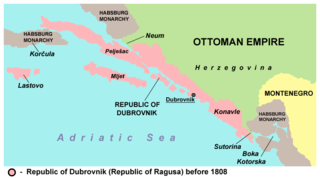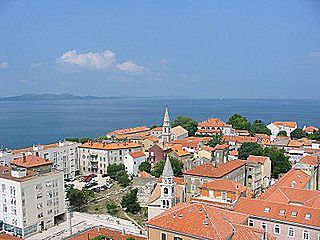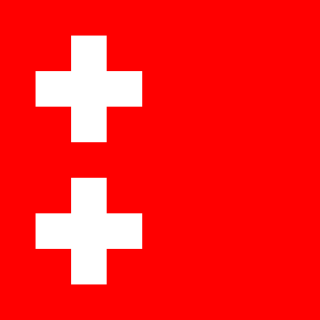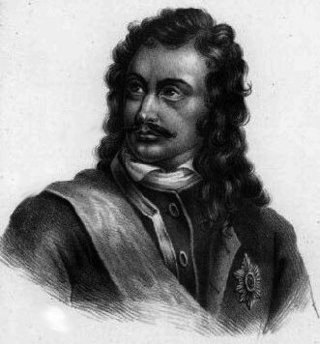
Dalmatia is a historical region on the eastern shore of the Adriatic Sea in Croatia, a narrow belt stretching from the island of Rab in the north to the Bay of Kotor in the south. The Dalmatian Hinterland ranges in width from fifty kilometres in the north, to just a few kilometres in the south; it is mostly covered by the rugged Dinaric Alps. Seventy-nine islands run parallel to the coast, the largest being Brač, Pag, and Hvar. The largest city is Split, followed by Zadar, Šibenik, and Dubrovnik.

Dalmatian or Dalmatic was a Romance language that was spoken in the Dalmatia region of present-day Croatia, and as far south as Kotor in Montenegro. The name refers to a tribe of the Illyrian linguistic group, Dalmatae. The Ragusan dialect of Dalmatian, the most studied prestige dialect, was the official language of the Republic of Ragusa for much of its medieval history until it was gradually supplanted by other local languages.
The Chronicle of the Priest of Dioclea or Duklja is the usual name given to a purportedly medieval chronicle written in the late 13th century by an anonymous priest from Duklja. Its oldest preserved copy is in Latin from the 17th century, while it has been variously claimed by modern historians to have been compiled between the late 14th and early 16th centuries.
The History of Dalmatia concerns the history of the area that covers eastern coast of the Adriatic Sea and its inland regions, from the 2nd century BC up to the present day.
Francesco Maria Appendini was an Italian Latin and Italian scholar who studied Slavic languages in the Republic of Ragusa. The French invasion prevented him from returning to Italy, and he adopted Republic of Ragusa as his own country. He took it upon himself to investigate its history and antiquities.

The Republic of Ragusa was an aristocratic maritime republic centered on the city of Dubrovnik in South Dalmatia that carried that name from 1358 until 1808. It reached its commercial peak in the 15th and the 16th centuries, before being conquered by Napoleon's French Empire and formally annexed by the Napoleonic Kingdom of Italy in 1808. It had a population of about 30,000 people, of whom 5,000 lived within the city walls. Its motto was "Non bene pro toto libertas venditur auro", a Latin phrase which means "Liberty is not sold for all the gold in the world".

Johannes Lucius was a Dalmatian historian, whose greatest work is De regno Dalmatiae et Croatiae, which includes valuable historical sources, a bibliography and six historical maps. Due to his critical approach, he is considered the founder of Croatian historiography.

Mavro Orbini (1563–1614) was a Ragusan chronicler, notable for his work The Realm of the Slavs (1601) which influenced Slavic ideology and historiography in the later centuries.
Vinko Pribojević was a Venetian Slavic historian and ideologue, best known as one of the founders of the early pan-Slavic ideology.

Dalmatian Italians are the historical Italian national minority living in the region of Dalmatia, now part of Croatia and Montenegro.
The Battle of Savra or the Battle of the Vjosë was fought on 18 September 1385 between Ottoman and much bigger Zetan forces, at the Savra field near Lushnjë. The Ottomans were invited by Karl Thopia to support him in his feud against Balša II.

Duchy of Saint Sava was a late medieval polity in southeastern Europe, that existed from 1448 up to 1482, when it was absorbed by the Ottoman Empire. It was ruled by the Kosača noble family, who held the title "Duke of Saint Sava". Their domains included southern parts of modern-day Bosnia and Herzegovina, extending to southern parts of modern-day coastal Croatia, northwestern Montenegro and southwestern Serbia. Its founder, Stjepan Vukčić Kosača, titled himself Herceg of Saint Sava, a title which would later give rise to the new name to the region: Herzegovina, and will be also used by the Ottomans as Hersek Sancağı, designating the Sanjak of Herzegovina.

Count Sava Lukich Vladislavich-Raguzinsky was a Serbian merchant-adventurer and diplomat in the employ of Peter the Great. He conducted important diplomatic negotiations in Constantinople, Rome and Beijing. His most lasting achievement was the Treaty of Kiakhta, which regulated relations between the Russian Empire and the Qing Empire until the mid-19th century. He penned a number of pamphlets, monographs, treaties and letters concerned with liberating the lands of the Slavs, then occupied by the Ottoman Empire and the forces of Leopold I.

Pomorje, also known as the Lands of Pomorje, is a medieval term, used to designate several maritime regions of Upper Dalmatia and its hinterland, that at the end of the 12th century, during the reign of Stefan Nemanja (1166–1196), became part of the Grand Principality of Serbia, and remained part of the medieval Kingdom of Serbia, whose rulers were styled with the title: "crowned king and autocrat of all Serbian and coastal lands".
The Vukanović dynasty, was a medieval Serbian dynasty that ruled over inner Serbia, centered in the Raška region, during the 11th and 12th century. Several members of the Vukanović dynasty also ruled in some other regions. The house may have descended from the Vojislavljević dynasty of Duklja. Vukanović dynasty was later succeeded in Serbia by the closely related Nemanjić dynasty.

Jerolim Kavanjin was a Croatian language poet from Split then in Republic of Venice, today in Croatia.

Mrnjava was a Serbian provincial nobleman, born in Zahumlje, a frontier province in the western Serbian Kingdom. Mrnjava is the eponymous founder of the notable Mrnjavčević family; his son Vukašin Mrnjavčević became the co-ruler of the Serbian Empire (1365–1371) as king during the fall of the Serbian Empire.

The Principality of Zeta is a historiographical name for a late medieval principality located in the southern parts of modern Montenegro and northern parts of modern Albania, around the Lake of Skadar. It was ruled by the families of Balšić, Lazarević, Branković and Crnojević in succession from the second half of the 14th century until Ottoman conquest at the very end of the 15th century. Previously, the same region of Zeta was a Serbian crown land, that had become self-governing after the fall of the Serbian Empire, when the Balšić family created a regional principality, sometime after 1360.
Zeta as a crown land was a medieval region and province of the Serbian state of the Nemanjić dynasty, from the end of the 12th century, up to the middle of the 14th century. During that period, regional administration in Zeta was often bestowed to various members of the ruling dynasty, who administered the region as a crown land.
Aleksandar Komulović was a Catholic priest and diplomat from Venetian Dalmatia. Part of the Counter-Reformation, and an early Pan-Slavist, he notably led a diplomatic mission aimed to forge an anti-Ottoman coalition in support of the West during the Long Turkish War, principally in the Balkans and among the Slavs. Although he failed his mission, he inspired the Serbs to revolt. The Papacy was aware that the Latin language of the liturgical books presented an obstacle for the conversion of the South Slavs from Islam and Orthodoxy to Catholicism. Komulović belonged to the first group of Jesuit missionaries and authors who attempted to spread Catholicism among the Slavs using liturgical books in Slavic. After his death, his propaganda activities were continued by Bartol Kašić.












